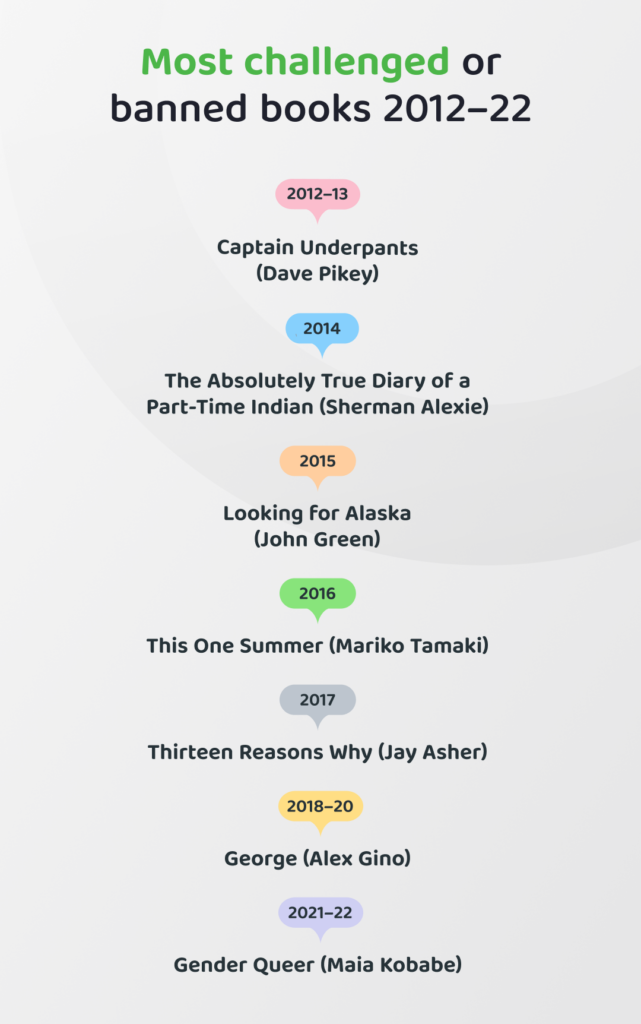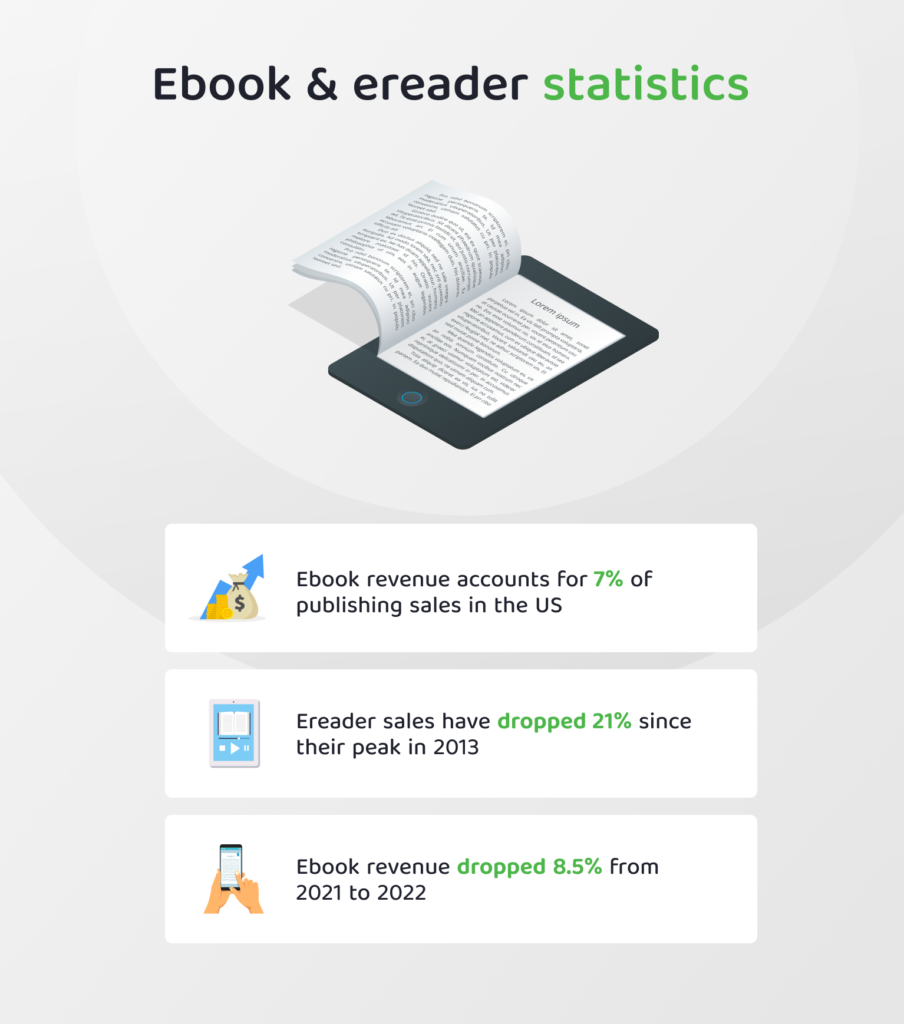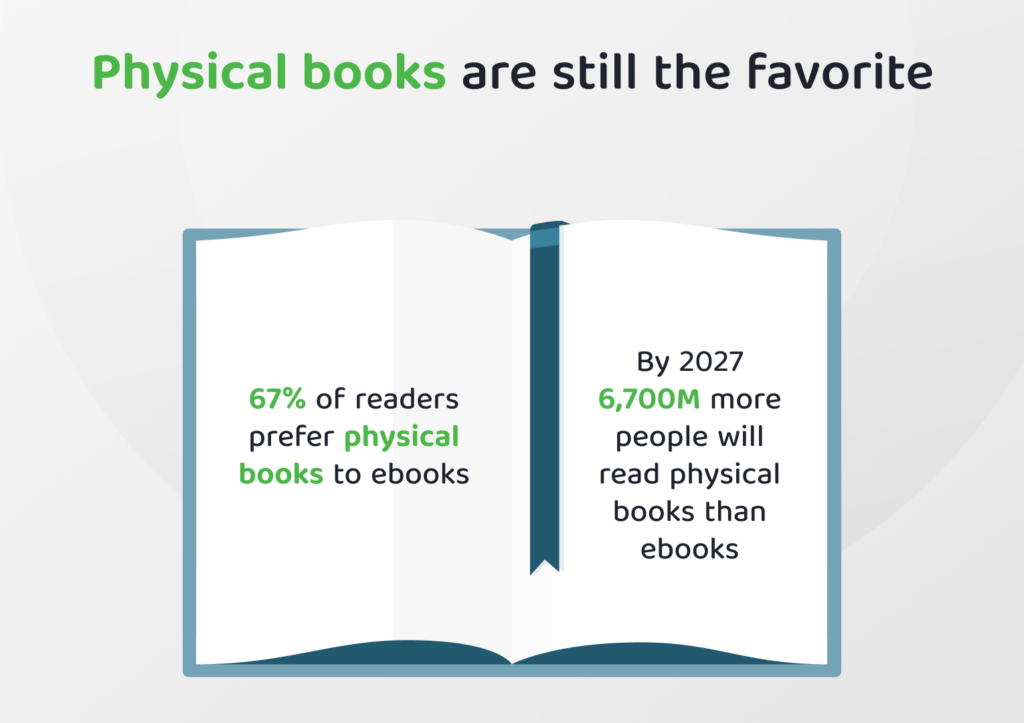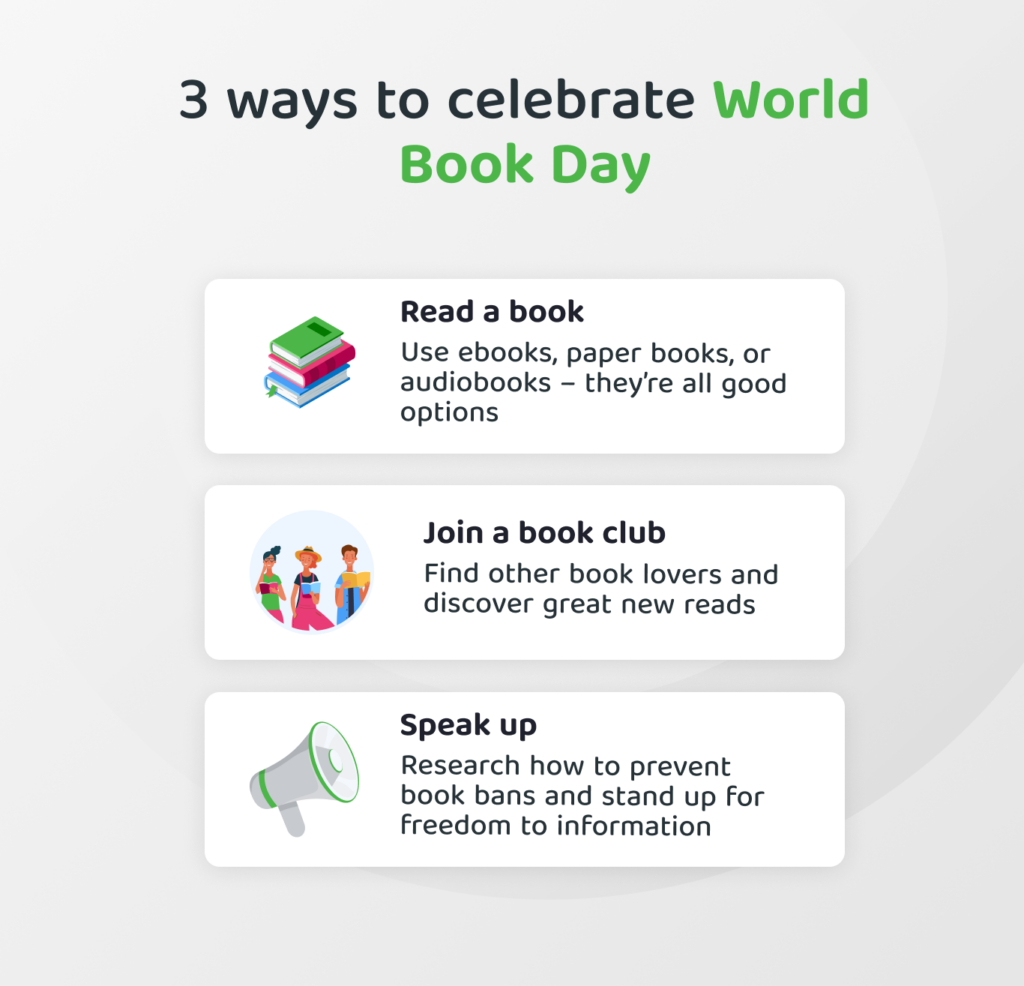Do You Read Me? Investigating the Most Banned Books + Ereader Stats

To celebrate World Book Day, we investigated the most banned books in the US and around the world. We also surveyed 1,158 people from across all 50 states in the US to find out what people think about book bans, how much they know about ban legislation, and how much people read. Dive in to find facts, stats, and general information about banned books on a US and international level.
Table of Contents
What Is World Book Day?Selective Reading — Book Bans in the US
Book Bans in Schools
Bans across the Globe
Shifting Formats: How Books Have Changed
Celebrate World Book and Copyright Day
Banned Books Aren’t Bad Books
What Is World Book Day?
The United Nations Educational, Scientific, and Cultural Organization (UNESCO) officially created World Book and Copyright Day on April 23, 1995. The organization chose this date because many prominent writers died in April, including William Shakespeare, Miguel de Cervantes, Mark Twain, and Bram Stoker. The event is a global celebration of the impact of books, authors, literacy, and reading on communities and people.
World Book Day is celebrated by over 100 countries, and each year, UNESCO picks a new city as the World Book Capital. The World Book Capital for 2024 is Strasbourg, France. Strasbourg has a long history of celebrating literary culture and has started programs like Reading for the Planet, a campaign that encourages youth to discuss environmental concerns and gain scientific knowledge.
World Book Capitals are expected to promote reading and literature for a full year, starting on World Book Day. During their 12 months as a World Book Capital, cities run events and initiatives to encourage reading and promote literature. This includes a focus on instilling a love of reading in children and young adults.
It’s worth noting that the UK and Ireland celebrate their own World Book Day on the second Thursday of March (this year on the 7th) every year. Twice the chance to acknowledge the importance and impact of books is never a bad thing, so why not celebrate both?
Selective Reading — Book Bans in the US
Freedom of speech and information hasn’t stopped book bans in the US. A study by Every Library shows that 39 states already had active book-banning legislation in 2023, with a further 113 bills introduced throughout the year. Despite the number of attempted bans, 58% of our survey participants weren’t aware of any legislation to ban books in their state. This is surprising, considering around 54% of our respondents don’t think banning books is acceptable under any circumstance.
The US isn’t the only country that bans books – and alarmingly, Words Rated says that general non-fiction accounts for approximately 25% of all global book bans. The general non-fiction category is made up of books that don’t easily fit into just one or two other categories (for example, something that covers finance, business, and economics). It includes books about factual human experiences and real events that could spark open discussion and change or offer comfort to others in the same or similar situations.
Book Bans in Schools
Book bans in the US are nothing new, and the list of banned or challenged books increases each year. Legislation records show that in 2022, over 2,500 different books were targeted for bans by multiple groups in the US. Unfortunately, these bans affect students and young adults the most.
Studies by PEN America showed 3,362 individual books across the US in the 2022–2023 school year, including 1,557 unique titles. This means that US students could be losing access to an average of 100+ new books each month. This includes books about sexual health and orientation, religious ideals, body image, mental health, and racial concerns, among others.
Some states are worse than others. For example, the same studies showed that 63% of all book bans from 2022–23 originated in just eight states: Florida, Missouri, Utah, Virginia, Tennessee, Georgia, Oklahoma, and West Virginia. Between them, these states have over 2,000 book bans. South Carolina pulls books from shelves before they are banned, only making them available after the book is reviewed. In Florida, challenged books are pulled and placed in the restricted section of libraries — an area that requires special permissions to access.
Making books unavailable before they are banned is problematic because reviews can take a while to complete and legislation moves slowly, further preventing free access to information. Considering there were more than 4,000 official ban request submissions in the US between 2012 and 2023, that could add up to a lot of missed information.

Why Books Get Banned or Challenged in the US
The biggest reason for book bans in the US (and worldwide) is sexual themes, as some governments or groups consider these topics to be taboo or inappropriate for certain age groups. Sexual topics include information about sexual orientation, gender identity, intercourse, body image, reproductive health, sexual abuse, and more.
As you can see in the table below, all five of the most banned or challenged books in the US in 2023 included LGBTQIA+ issues, sexual abuse, or sexually explicit content in general.
| Top 5 Most Recently Challenged/Banned Books in the US & Why | ||
|---|---|---|
| Book | Reason | |
| 1. Gender Queer: A Memoir by Maia Kobabe | LGBTQIA+ content Sexually explicit content |
|
| 2. All Boys Aren’t Blue by George M Johnson |
LGBTQIA+ content Sexually explicit content |
|
| 3. The Bluest Eye by Toni Morrison |
Sexually explicit content Domestic abuse |
|
| 4. Flamer by Mike Curato |
LGBTQIA+ content Sexually explicit content |
|
| 5. Looking for Alaska by John Green tied for fifth with The Perks of Being a Wallflower by Stephen Chebosky |
LGBTQIA+ content Sexually explicit content LGBTQIA+ content Sexually explicit content Domestic abuse |
|
Other common reasons for book bans include morality issues, religious themes, and offensive language. Advocates for book bans consider them a way to protect children and young people who may get a hold of content deemed inappropriate.
Book bans aren’t always permanent: freedom of information and free speech advocates fight back and laws change, leading to books being removed from ban lists in the US. This includes the following books that were all made available after obscenity laws were overturned by the Supreme Court in 1959:
- The Canterbury Tales by Geoffrey Chaucer
- Candide by Voltaire
- Elmer Gantry by Sinclair Lewis
Repealing the obscenity laws didn’t stop states from continuing to ban books with themes they felt were obscene, though. Many books were banned for several years, including
- Tropic of Cancer by Henry Miller (banned nationwide 1934–1960)
- Naked Lunch by William S. Burroughs (banned in Massachusetts 1962–1966)
- Uncle Tom’s Cabin by Harriet Beecher Stowe (banned in the Southern US 1861–1865)
- Moll Flanders by Daniel Defoe (banned nationwide 1873–1959)
Many books banned in US states are also banned in other countries, and many books considered to be classics are still on ban lists on other continents. For example, Naked Lunch is still banned in Australia.
Bans across the Globe
Even on a global level, sexual or explicit content remains a key reason that books are banned. Though the US often bans books due to sexually explicit and LGBTQIA+ content, it rarely enforces bans for profanity or drugs, or religious or political reasons.
Classic books, which are often considered to be mild by most standards, face the longest-standing bans in several countries. Global bans are primarily set for profanity and sexual content, but many books have also been banned for drug use, religion, political views, and racism. For example, one of the most commonly banned religious texts in the world is the Bible.
| Top 5 Most Recently Challenged/Banned Books in the US & Why | ||
|---|---|---|
| Book | Reason | |
| 1. 1984 by George Orwell | Pro-communist Sexual content Anti-communist |
|
| 2. The Adventures of Huckleberry Finn by Mark Twain |
Racism | |
| 3. The Catcher in the Rye by JD Salinger |
Profanity Unsuitable for children |
|
| 4. The Color Purple by Alice Walker |
Sexual content Profanity Unsuitable for children Racism |
|
| 5. The Great Gatsby by F. Scott Fitzgerald |
Drugs Profanity Sexual content |
|
Book bans exist across the world, some for extreme reasons. To list all the banned books in every continent would take far more space than we have here, but we’ll discuss a few of the more thought-provoking bans.
Orwell’s Animal Farm is banned in Cuba for containing satirical and critical depictions of communism. High Point University points out that many authors in Cuba have faced extensive criticism for writings that criticize the government.
In parts of Western Asia and the Middle East, The Satanic Verses by Salman Rushdie is banned due to concerns over what some religious leaders called ‘blasphemous’ references to the Muslim faith. India and some countries in Africa also banned the book.
In parts of Eastern Asia, The Catcher in the Rye by J.D. Salinger is on the banned book list. According to High Point University, this is due to themes that include promoting rebelliousness and objectivity, containing content about mental health issues like feelings of despondency, and being open about teenage sexuality.
How Readers Feel about US Book Bans
We wanted to see how readers felt about US book bans, so we surveyed over 1,100 participants. Our survey included questions about reading preferences, book bans, and current bans. Some questions were created specifically to test the participant’s knowledge of book bans in the US.
Respondents aged from 18–69+, with approximately 28% being aged 43–58 and half as many (an average of 14%) in all other age groups (18–26, 27–34, 35–42, 59–68, and 69+). There was also an almost-equal balance of female (52%) and male (47%) participants. We had responses from people in all 50 states, with the largest proportions of responses coming from California (12%), New York (10%), and Florida (8%). There were just one or two respondents in some states, including North and South Dakota and Hawaii.
As many of the questions were about book bans and their impact on children, we were pleased to see that approximately 40% of our respondents were parents. Children’s safety and protection are one of the main reasons books are banned, so the differing perspectives gave us a more balanced view on the overall opinion of book bans in schools.
Parents’ Thoughts on Book Bans
As previously mentioned, many book bans are done under the pretext of protecting children. Books are often designated to specific target age groups to limit how much access children and young adults have to information about certain topics before a given age.
It could be argued that completely banning books is a less effective measure than encouraging parents to be more mindful and involved in what their children are reading. It seems a majority of our respondents agree: 64% of our survey respondents thought parents should decide what their children read, and 47% of parents that responded felt it wasn’t right to ban books under any circumstance.
Although more parents were okay with banning books in some circumstances than people who don’t have children, they were not more aware of legislation around book bans in their states. Our data also showed that overall, people who didn’t have children were more okay with never banning books (59% as opposed to 46%), and with never banning books in schools than parents were (47% as opposed to 34%).
All Participant Results
We discovered that 44% of all respondents believed no book should be banned in public spaces. On the other end of the spectrum, 20% of respondents thought it was okay to ban books if they disagree with their content. Still, the knowledge of currently banned books in the US was split.
One of our data points was a multiple choice question asking respondents to select which books they thought were banned in the US from a list of eight titles. Three of the titles were banned: The Color Purple by Alice Walker, The Hate U Give by Angie Thomas, and Gender Queer: A Memoir by Maia Kobabe. The other titles included were: Becoming by Michelle Obama, Girl, Woman, Other by Bernadine Evaristo, Where the Crawdads Sing by Delia Owens, Homo Deus by Yuval Noah Harari, and Angels and Demons by Dan Brown.
50% of those surveyed didn’t think any of the titles we mentioned were banned in the US. Gender Queer was correctly selected from the options as banned by 31% of respondents, and each of the non-banned books was selected by 12–18% of participants. This might be in line with some of our other findings: 21% of participants thought it was okay to ban books if they discuss gender issues, with 16% thinking books that discuss gender should be banned from public spaces.
It’s interesting that despite the large number of respondents who are against book bans, people seem to have very little knowledge of which books are actually banned. It’s more interesting when you look at how the data splits between people who claimed that they don’t read versus people who do: 81% of self-professed non-readers didn’t think any of the books on our list were banned, almost 30% more than people who do read.
Even more interesting is the focus on gender and sexuality. While 44% of respondents don’t think any book should allow for books to be banned, 35% think that explicit content or obscenity is a good reason to remove books. Alarmingly, 14% more people are concerned with explicit content than with terrorism, with 21% of respondents thinking terror-related books should be banned.
We also asked participants if they thought banning books contradicted their right to freedom, and 61% replied yes.
Shifting Formats: How Books Have Changed
People were creating books long before the invention of the printing press. The oldest known written book is the Diamond Sutra, though non-bound texts date back much further. Diamond Sutra was written in 868 AD by a Buddhist monk in Dunhuang, China.
While early printers used wooden blocks and other methods to produce texts, Johannes Gutenberg’s printing press in 1450 revolutionized books as we know them and made their mass production possible. The first book to be printed on a large scale was the Gutenberg Bible in 1452 – around 180 of the bibles were produced. Mass printing has come a long way since then, and books are now printed using digital presses.
They work much like a standard office printer, but are far more sophisticated and allow for a faster turnaround time as they don’t require plates like traditional presses. Digital presses are also much cheaper to run, primarily because they can produce copies on demand. This means they only need to produce the number requested, instead of over printing books based on estimated demand.
Printed books aren’t your only option: ebooks and audiobooks provide an entirely different reading experience.
The Introduction of Ebooks & Ereaders
The concept of an ereader first came about in the 1930s with the Readie, which was essentially what we know today as a projector. 40 years later, Michael Hart built the first digitized version of the US Declaration of Independence by typing it up and sharing it on ARPANET. The first mass-produced digital ereader didn’t come about until 1997 when Rocket became available – 26 years after the first ebook was released.
Rocketonly saw limited success, but it did create a push for digital books and a more mainstream ereader. US libraries started providing free ebooks to readers through their websites in 1998, and in 2007, Amazon created the Kindle, and two years later, Barnes and Noble released the Nook.

Are Reading Apps and Ereaders Safe?
Any device you can connect to the internet is susceptible to malware, cyberattacks, and other online threats. This is especially true considering how many ereaders are multi-purpose and allow you to access email, browser, and games. Unsafe public network connections, buggy apps, and carelessness on behalf of the user can make ereaders unsafe in the following ways.
- Ignoring security updates may create vulnerabilities for cybercriminals to exploit.
- Some apps may unknowingly contain malware that can damage your system.
- Ebooks from third-party sites can also host malicious software.
It’s important to keep your ereader and ereader apps up to date and use additional security to help protect your system. If your ereader supports firewalls, antivirus, or VPN apps, installing a trusted service on your device is never a bad idea. Using a VPN – especially a dedicated IP VPN – is a particularly good idea if you regularly purchase new titles online as the encryption these services use helps protect your payment details and keep your data safe. If you’re using a mobile device like a tablet or smartphone to access an ereader app, you should be able to install any of the above services for your specific operating system.
Are Digital Books Making Print Versions Obsolete?
According to our survey, 66% of respondents usually read physical books, with 63% of 18–26 year olds preferring paper to digital. While younger people are sometimes blamed for a perceived decline in printed book sales, other studies corroborate our findings: researchers have found that 68% of people aged 18–29 in the US prefer to read physical books.
It’s estimated that by 2027, physical book sales will still eclipse ebook sales by over half a billion dollars. This doesn’t mean that ebooks aren’t popular, but it does show that print versions are far from obsolete.

The Benefits of Ereaders over Physical Books
Ereaders and ebooks have many benefits: they can hold multiple titles and require no paper. Books become available faster and can be distributed to the masses much more easily. Ereader apps mean you can read ebooks on your phone, tablet, or computer, as well as a designated ereader, so taking your favorite books anywhere is less cumbersome. After all, you can fit them all in one place.
In addition, ereaders don’t tear or fade like physical books. They are also affordable: ebooks are cheaper than paper books, and if you need a new copy of the book you ordered, you can download it to your device again without repayment.
The Benefits of Physical Books over Ereaders
Many avid readers will tell you nothing beats the smell and feel of a physical book. While they take a fair amount of paper to produce, they are often produced from recycled paper, and damaged books can be recycled more effectively than electronic devices. Another huge bonus is that physical books won’t run out of battery four pages from the end of your story.
Reading a physical book is easier on your eyes, too, as you don’t have the strain of staring at a lit background for hours. Perhaps the biggest benefit of reading a physical book is you can’t connect it to the internet, so you have fewer distractions during your reading time and your personal information remains safe.
Celebrate World Book and Copyright Day

This World Book and Copyright Day, we encourage you to celebrate by enjoying a book that made it off the ban list or that may be banned in another state or country, but available in yours. We’ve included a few examples for specific age ranges below:
- Young children (0–7): Red Riding Hood by the Brothers Grimm
- Children (6–9): Captain Underpants by Dav Pilkey
- Pre-teen (10–13): Harry Potter (series) by JK Rowling
- Teen (14–18): The Hate U Give by Angie Thomas
- Young Adult (19–24): The Color Purple by Alice Walker
You can also revisit a classic banned book like To Kill A Mockingbird, Animal Farm, or The Adventures of Huckleberry Finn.
Another way to celebrate the day is to get involved in local groups that advocate for freedom of information and work to prevent book bans in your country. Pay attention to active state and government legislation seeking to ban specific books, and use your voice to speak up against the censorship of information and free speech.
Banned Books Aren’t Bad Books
Banned books aren’t necessarily ‘bad’ books. Book bans ultimately boil down to one group wanting to make a larger decision for the masses on the basis of general opinion, religion, morality, or politics, despite the possible implications to other people’s right to freedom. Reading a banned book this World Book & Copyright Day is a great way to gain a new perspective.
It’s important to remember many of these books offer unique outlooks on social climate, personal discovery, equality issues, and more. Without them, some people wouldn’t have a voice and even more may never feel understood. You can help prevent book bans by monitoring active state and government legislation. Even something as simple as joining an advocacy group for freedom of speech and information can make a big difference. The more voices, the better.
